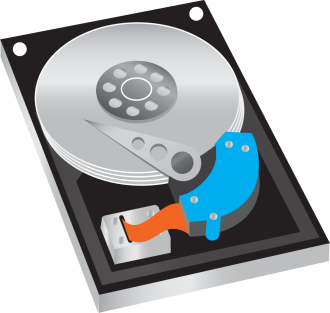As the saying goes, there is data you back up, and the rest that you don’t need, but how many of us are one hundred percent reliable; and is our vital information really safe in the case of a hard drive catastrophe? When that terrible day dawns, and the initial feeling of sickness and panic wears off, we turn to the data recovery experts and their black arts to recover our vital information; but how do they do it? There are two types of hard disk failure, physical and logical.
Physical Recovery
In the case of a physical failure it is normally due to the computer receiving a hard knock while it is running, the motor seizing, extremely high temperature causing the circuit board to fail, or the power supply being interrupted while the disk is being written. Recovering data from a failed hard drive makes brain surgery look clumsy by comparison; as the failed components have to be repaired in order to read the original data, and the tolerances are minute; the heads in a hard drive sit barely one micron above the spinning platters. The process of repairing the failed electronics needs to take place in an ultra-clean environment; a minimum standard would be a ‘class 100 clean room’ which has a tolerance of a maximum of 100 specks of dust, larger than half a micron, per cubic foot of air. The platters on which the data is stored are disks of a non-magnetic material covered in an ultra-thin magnetic coating, 10-20nm thick. It may be necessary to read these platters separately, mounted in a new hard drive; removing and setting these up to run without causing irreparable damage is a highly delicate procedure. Once read, the data will be stored safely for the relieved client to use once more.

Logical Recovery
A logical failure of a hard disk means that the components are still working; but the data is corrupted and unreadable: virtually the opposite of a physical breakdown. The first step in retrieving lost files is to scan the drive to establish if the file system can be repaired, which might mean that a partition needs to be fixed; after which the drive can hopefully be restored to a point before the failure took place, and the data retrieved. If this does not work then a low level scan is required, examining in minute detail the whole hard drive to retrieve the files. This is a slow process and could take a whole working day, and another to reassemble the data into a readable format.
Some of this can actually be achieved by a tech savvy computer user who has access to the right software. Since logical failures are such a major issue it is possible to find recovery programmes for all the well known operating systems currently in use. Sometimes it is user error that has deleted an important registry entry that prevents the drive from booting; ironically, it is often attempts to remove junk files to speed up the system that does the damage. Nasty viruses, or incorrect formatting of the hard drive.
Just because a file has been ‘deleted,’ does not mean that it no longer exists, rather that the route to finding it has gone and you have now enabled your computer to write over that space. This means that if you have not written over that area, the file is still relatively easy to recover, which is worth knowing if you really want to eradicate all traces of a file. Data recovery can be used for nefarious purposes as well.
Featured images:
- License: Image author owned
- License: Image author owned
By Nick Davison
Guildford Data Recovery are part of one of the UK’s biggest data recovery groups. Easy Recovery has branches all over the UK and operates on a no recovery, no fee payment model.
